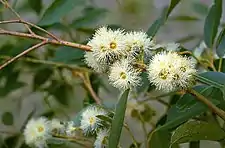| Red mahogany | |
|---|---|
 | |
| Red mahogany at Chatswood | |
| Scientific classification | |
| Kingdom: | Plantae |
| Clade: | Tracheophytes |
| Clade: | Angiosperms |
| Clade: | Eudicots |
| Clade: | Rosids |
| Order: | Myrtales |
| Family: | Myrtaceae |
| Genus: | Eucalyptus |
| Species: | E. resinifera |
| Binomial name | |
| Eucalyptus resinifera | |



Eucalyptus resinifera, commonly known as red mahogany or red messmate,[2] is a species of medium-sized to tall tree endemic to coastal areas of eastern Australia. It has rough, stringy or fibrous bark on the trunk and branches, lance-shaped adult leaves, flower buds in groups of between seven and eleven, white flowers and hemispherical, conical or cup-shaped fruit.
Description
Eucalyptus resinifera is a tree that typically grows to a height of 45 m (148 ft) and forms a lignotuber. It has rough, stringy or fibrous, reddish brown bark in long strips on the trunk and branches. Young plants and coppice regrowth have dull green, lance-shaped leaves that are paler on the lower surface and 65–155 mm (2.6–6.1 in) long, 17–45 mm (0.67–1.77 in) wide. Adult leaves are arranged alternately, dark, glossy green on the upper surface, paler below, lance-shaped or curved, 80–180 mm (3.1–7.1 in) long and 20–36 mm (0.79–1.42 in) wide, tapering to a petiole 15–25 mm (0.59–0.98 in) long and with a fine, long point. The flower buds are arranged in leaf axils in groups of seven, nine or eleven on an unbranched peduncle 10–22 mm (0.39–0.87 in) long, the individual buds on pedicels 5–8 mm (0.20–0.31 in) long. Mature buds are oval to spindle-shaped, 10–16 mm (0.39–0.63 in) long and 4–7 mm (0.16–0.28 in) wide with a conical, horn-shaped or beaked operculum. Flowering occurs in December and the flowers are white. The fruit is a woody, hemispherical, conical or cup-shaped capsule 3–8 mm (0.12–0.31 in) long and 6–10 mm (0.24–0.39 in) wide with the valves protruding strongly.[2][3][4][5]
Taxonomy and naming
Eucalyptus resinifera was first formally described in 1790 by James Edward Smith in John White's book, Journal of a Voyage to New South Wales, from material collected by White at Port Jackson. The specific epithet (resinifera) is from the Latin resiniferus meaning "resin-bearing".[2][6][7]
In 1990, Lawrie Johnson and Ken Hill described two subspecies, and the names have been accepted by the Australian Plant Census:[8]
- Eucalyptus resinifera subsp. hemilampra (F.Muell.) L.A.S.Johnson & K.D.Hill[9] (originally described by Ferdinand von Mueller as Eucalyptus hemilampra);[10]
- Eucalyptus resinifera Sm. subsp. resinifera.[11]
The two subspecies differ in the length of the operculum. In subspecies resinifera it is less than three times as long as the floral cup and in species hemilampra more than three times as long.
Distribution and habitat
Red mahogany is found in coastal areas from Nowra in New South Wales to Gladstone in Queensland, with disjunct populations further north as far as Coen. It grows in forest on flats, valleys and gentle slopes, preferring soils of medium to high fertility. Subspecies hemilampra occurs between Taree and Gladstone, whilst subspecies resinifera occurs between Nowra and Taree, then disjunctly north of Gladstone.[2][3][12]
Ecology
Red mahogany has wildlife value as a food tree for koalas.[13][14][15][16]
Uses
The timber of red mahogany is well regarded for its high quality, being very hard and heavy, and having dark-red heartwood. It has multiple uses including flooring, panelling, cladding, boat building, railroad ties and general construction. It is also a good choice for making poles and charcoal.
E. resinifera has been exported for use as a crop plant on plantations in varying locales in Africa (Madagascar, South Africa and Zimbabwe), Western Europe (Italy and Portugal), and the U.S. (Hawaiian Islands).[17][18][19][20]
References
- ↑ "Eucalyptus resinifera". Australian Plant Census. Retrieved 12 December 2019.
- 1 2 3 4 "Eucalyptus resinifera". Euclid: Centre for Australian National Biodiversity Research. Retrieved 29 May 2020.
- 1 2 Chippendale, George M. "Eucalyptus resinifera". Australian Biological Resources Study, Department of the Environment and Energy, Canberra. Retrieved 12 December 2019.
- ↑ Hill, Ken. "Eucalyptus resinifera". Royal Botanic Garden Sydney. Retrieved 12 December 2019.
- ↑ Wild Plants of Greater Brisbane, Queensland Museum, 2003, Michelle Ryan (ed.) ISBN 0-9751116-2-0
- ↑ "Eucalyptus resinifera". APNI. Retrieved 12 December 2019.
- ↑ White, John (ed.); Smith, James Edward (1790). Journal of a Voyage to New South Wales. London: J. Debrett. pp. 231–234. Retrieved 12 December 2019.
{{cite book}}:|first1=has generic name (help) - ↑ Johnson, Lawrence A.S.; Hill, Kenneth D. (26 September 1990). "New taxa and combinations in Eucalyptus and Angophora (Myrtaceae)". Telopea. 4 (1): 37–108. doi:10.7751/telopea19904916.
- ↑ "Eucalyptus resinifera subsp. hemilampra". Australian Plant Census. Retrieved 12 December 2019.
- ↑ "Eucalyptus hemilampra". APNI. Retrieved 12 December 2019.
- ↑ "Eucalyptus resinifera subsp. resinifera". Australian Plant Census. Retrieved 12 December 2019.
- ↑ A Field Guide to Eucalypts Volume 1 Brooker & Kleinig page 135 ISBN 0-909605-62-9
- ↑ "Koala tree foods". Archived from the original on 22 July 2011. Retrieved 27 August 2009.
- ↑ "Trees for Koalas". Australian Koala Foundation. Archived from the original on 13 September 2009. Retrieved 27 August 2009.
- ↑ Mark Snodgrass (3 July 2009). "Eucalyptus resinifera". Organic Matter. Retrieved 27 August 2009.
- ↑ "Koala Plantation Program". Fauna Australia Wildlife Retreat. 23 February 2009. Archived from the original on 13 October 2009. Retrieved 27 August 2009.
- ↑ Elbert L. Little, jr.; Roger G. Skolmen (2003) [1989]. "Common Forest Trees of Hawaii (USDA Agriculture Handbook No. 679)". USDA. Retrieved 27 August 2009.
- ↑ D. Louppe; A.A. Oteng-Amoako; M. Brink, eds. (2008). Timbers 1. PROTA. ISBN 9789057822094. Retrieved 27 August 2009.
- ↑ "Red Mahogany". Timber Development Association. Retrieved 27 August 2009.
- ↑ Larouse Pocket Guide Trees of Britain and Europe page 164 ISBN 0-7523-0017-2